Ijraset Journal For Research in Applied Science and Engineering Technology
- Home / Ijraset
- On This Page
- Abstract
- Introduction
- Conclusion
- References
- Copyright
Preparation and Evaluation of Cream Containing Betel Leaf Extract for Removal of Cutaneous Warts
Authors: Akshay S. Gavali , Prof. Neha B. Gaikwad , Dr. Rajendra M. Kawade
DOI Link: https://doi.org/10.22214/ijraset.2024.63486
Certificate: View Certificate
Abstract
Warts are common skin growths caused by the human papillomavirus (HPV). They can appear on any part of the body but are most commonly found on the hands, feet, and genitals. Warts are usually harmless but can be unsightly or cause discomfort, especially if they are frequent friction or pressure. There are several types of warts, including common warts, plantar warts (on the soles of the feet), genital warts, and flat warts (often found on the face). Creams are semisolid dosage form containing one or more drugs substances dissolved or dispersed in a suitable base. They are emulsion of either W/O, O/W creams are uses for various purposes. Wart removal cream contains some synthetic substances as well as herbal ingredients like betel steam which is having antiviral activity against the human papilloma virus (HPV). Then calcium carbonate and sodium hydroxide slowly absorbed into the skin causing rupturing of the skin cells that contains the wart virus. To prepare wart removal cream sodium hydroxide and calcium carbonate along with the aqueous extract of betel leaf by maceration with the excipients such as stearic acid, glycerin, methyl paraben, distilled water are used. Finally, the cream is evaluated with various parameters such as physical and chemical properties like pH, viscosity, spreadability, texture. As this cream has clove oil which is used as an analgesic to avoid the irritational pain. The pH of the cream is supposed to be basic and around 12-12.5. During the evaluation the pH of the cream was found out to be 12.1. Cream was easily spreadable and it had a pleasant appearance.
Introduction
I. INTRODUCTION
A. "What are warts?
Warts are benign (noncancerous) growths that can develop on your skin and mucosa (like Inside your mouth). The human papillomavirus (HPV) Causes warts. There are over 100 Subtypes (strain) of HPV, but only a few types can cause warts on certain parts of your body. Warts are generally harmless, but they can be bothersome and sometimes painful
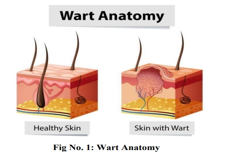
1. Types of warts
Healthcare providers classify warts based on how they look, the HPV strain (type) that causes them, and/or what warts parts of your body they affect:
a. Common (Verrucae vulgaris): Common warts typically appear on your hands. They most often feel like rough bumps and can have black dots that look like seeds. The black dots are actually smothered and dead capillaries. They range from the size of a pinhead to the size of a pea. HPV types 2 and 4 (most common) cause common warts in addition to types 1, 3, 7, 27, 29 and 57.
b. Plantar Warts: Planter warts typically form on your feet, especially the soles (plantar surface) of your feet. They’re often flat or grow inward and can have black dots. They can become quite large and cause pain when you stand or walk. HPV types 1, 2, 4, 27 and 57 cause plantar warts.
c. Mosaic Warts: These warts are white and about the size of a pinhead. They typically form on the balls of your feet or under your toes. But they can spread and cover larger areas of your foot. Mosaic warts are flatter than plantar warts, and they only rarely hurt when you walk. HPV type 2 causes mosaic warts.
d. Flat warts: These warts can develop anywhere on your body. They’re smaller and smoother than other warts and tend to grow in large numbers, like 20 to 100 at a time. HPV types 3, 10 and 28 cause flat warts.
e. Filiform Warts: These warts look like long threads that stick out. They often grow on your face around your mouth, eyes and nose. HPV types 1, 2, 4, 27 and 29 cause filiform warts.
f. Genital warts: These warts affect your genitals and rectum (anal warts). It’s a sexually transmitted infection (STI) that gets passed through skin-to-skin contact. Genital warts are small, hard nodules with rough surfaces. HPV types 6 and 11 cause about 90% of genital warts.
g. Butcher’s warts: These warts tend to develop on the hands of people who handle raw meat (like butchers) and those whose occupation involves frequent exposure to a cold, moist environment. HPV type 7 causes Butcher’s warts.
h. Focal epithelial hyperplasia (Heck’s disease): This is a rare condition in which warts develop inside your mouth (on the mucosa). The warts are generally soft and whiteish to mucosal-coloured. HPV types 13 and 32 cause Heck’s disease.
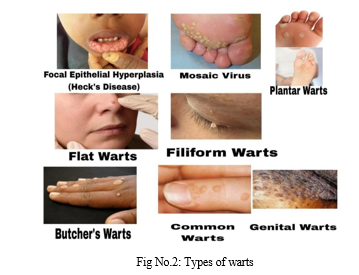
Are warts harmful?
Warts, in general, are benign (noncancerous). But they can become bothersome when they affect your self-esteem or make it difficult to do everyday things like walking or wearing shoes.
How common are warts? Warts are common.
They affect approximately 10% of the worldwide population. They’re even more common in school-aged children, affecting 10% to 20% of this age group. Warts are also more likely to affect people who are immunocompromised and people who handle raw meat regularly (like butchers)
2. Symptoms
Common warts usually occur on your fingers or hands and may be:
• Small, fleshy, grainy bumps
• Rough to the touch
• Sprinkled with black pinpoints, which are small, clotted blood vessels
3. Causes
Common warts are caused by the human papillomavirus (HPV). The virus is quite common and has more than 150 types, but only a few cause warts on your hands. Some strains of HPV are acquired through sexual contact. Most forms, however, are spread by casual skin contact or through shared objects, such as towels or washcloths. The virus usually spreads through breaks in your skin, such as a hangnail or a scrape. Biting your nails also can cause warts to spread on your fingertips and around your nails. Each person's immune system responds to the HPV virus differently, so not everyone who comes in contact with HPV develops warts.
4. Topical Drug Delivery
Over the last decades the treatment of illness has been accomplished by administrating drugs to human body via various roots namely oral, sublingual rectal, parental topical inhalation etc. Topical delivery can be defined as the application of a drug containing formulation to the skin to directly treat cutaneous disorder or the cutaneous manifestations of a general disease (e.g. Psoriasis) with the intent of containing the pharmacological or the effect of drug to the surface of the skin or within the skin semisolid formulations in all their diversity dominate the system for topical delivery. Topical drug delivery is a method of delivering medication directly to the skin or mucous membranes to treat localized conditions such as skin disorders, pain, inflammation, and infections. The skin is the largest organ in the body and has a complex structure with different layers, each of which can affect drug delivery. Topical drug delivery can take many forms, including creams, lotions, ointments, gels, patches, sprays, and foams. These formulations can be applied directly to the affected area or through a medical device such as an inhaler or a nasal spray. The advantages of topical drug delivery include targeted delivery, reduced systemic side effects, and increased patient compliance due to the ease of use and convenience of topical formulations. Topical drug delivery can also offer faster onset of action, as the medication is delivered directly to the site of action.
5. Advantages of Topical Drug Delivery System
a. Avoidance of first pass metabolism.
b. Convenient and easy to apply.
c. Avoid of risk.
d. Inconveniences of intravenous therapy and of the varied conditions of absorption like pH Changes presence of enzymes gastric emptying time etc
e. Achievement of efficacy with lower total daily dosage of drug by continuous drug input.
f. Avoid fluctuation of drug levels inter and intra patent variations.
g. Most drugs have a high molecular weight and are poorly lipid soluble, so are not absorbed via skin or mucous membrane.
6. Introduction of Wart Removal Cream
A cream is basically a mixture of oil and water. As you know oil does not readily dissolve or disperse in water, so to allow this to happen, a dispersing agent called an emulsifier is added to the mixture. A cream is therefore a type of emulsion, made of a water phase and an oil phase.
Oil in water emulsions are prepared by dispersing a lesser quantity of oil in a greater quantity of water. The oil phase is called the ‘internal phase’ because the emulsifier molecules enclose the minute oil droplets as they disperse them through the water medium, which is referred to as the ‘external phase’. The oil is ‘wrapped within the water’. Such creams have a lighter feel, are more easily absorbed into the skin without leaving an oily residue. Wart removal cream which is synthesized to remove the wart is made up of the betel leaf extract and it consists of other excipients such as Stearic acid, Glycerine, Calcium carbonate, Sodium hydroxide and methyl paraben. There is Clove oil included which is added as an Analgesic. As there is a bit of pain sensation and irritation that's why it is important to add clove oil. [9]
a. Calcium Carbonate: Calcium Carbonate is a great bulking agent and also functions as an absorbent, and opacifying agent in various cosmetic formulations. It helps to enhance the texture and thickness of creams, lotions, and powders, providing a smooth and silky feel.
b. Sodium Hydroxide: Sodium Hydroxide is used as a pH adjuster in cosmetics. It is a strong base, meaning its pH is well above neutral pH 7. It’s important to maintain your skin’s acid mantle this natural level of acidity to keep moisture in and help protect your skin from various damaging elements, from bacteria and viruses to environmental toxins and pollutants.
c. Methylparaben: Methylparaben is one of the most common parabens. where it prevents germ growth. It can also be found naturally in some fruits and may be used as a food preservative or an antifungal preservative. [10
7. Mechanism of Wart Removal Cream
The alkalinity of slaked lime facilitates the entry of betel leaf components into the infected cell by disturbing the intercellular matrix of the wart, dissolving the protein and thus changing the physical chemical properties of infected cell membranes. Entry of the betel leaf components and/or the Slaked lime then produces a more effective cauterization of wart and a more aesthetically acceptable Scarring afterwards. The mode of treatment itself may have Significant impact on the efficacy of combination.
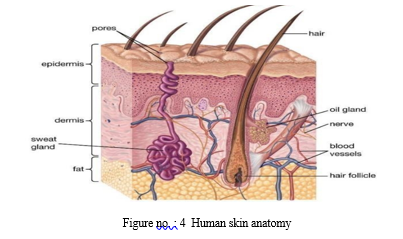
8. Skin components
Skin has mesodermal cells, pigmentation, or melanin resided by melanocytes, which absorb some of the potentially dangerous Ultraviolet radiation (UV) in sunlight. It also contains DNA-repair enzymes that help reverse UV damage, and people who lack the genes for these enzymes suffer high notes of skin cancer. One form predominantly produced by UV light, malignant melanoma, is particularly invasive, causing it spread quickly, and can often be deadly. Skin pigmentation varies among populations in a striking manner. [12]
B. Function of Skin
Protection: The skin acts as a barrier between the internal organs and the outside world, protecting the body from physical, chemical, and microbial damage.
- Sensation: The skin contains sensory receptors that enable to feel touch, pressure. temperature, and pain.
- Thermoregulation: The skin helps regulate body temperature by controlling the amount of heat that is lost or retained through the process of sweating and shivering Vitamin D synthesis: The skin synthesizes vitamin D when exposed to sunlight, which is important for bone health.
- Immune defence: The skin contains immune cells that help defend against infection and disease. Excretion: The skin excretes waste products such as sweat, which helps regulate the body's water and electrolyte balance.
- Absorption: Certain substances can be absorbed through the skin, including medications and sum nutrients. Control of evaporation the skin provides a relatively dry and semipermeable. Loss of this function contributes to the massive fluid loss in burns.
II. DRUG PROFILE
A. Betel Leaf
Betel leaf has antiviral properties and its component Appear to be better extracted when combined with Slaked lime. This invention describes a technique for the removal of warts by applying Slaked lime to wart and scratching the wart surface using the stem of betel leaf. The possibility exists that betel leaf acts as an antiviral agent that invades the infected epidermal cells and kills the virus within the cells. It is also possible that the alkalinity of slaked lime facilitates the entry of betel leaf components into the infected cell by disturbing the intercellular matrix of the wart, dissolving the protein and thus changing the physical chemical properties of infected cell membranes. Entry of the betel leaf components and/or the Slaked lime then produces a more effective cauterization of wart and a more aesthetically acceptable Scarring afterwards. The mode of treatment itself may have Significant impact on the efficacy of combination.
Benefits Of Betel Leaf:
- Betel leaves have antiviral property and help in relieving headaches.
- Fighting against cancer.
- Healing wounds.
- May reduce gastric ulcers, diabetes, and allergies.
- Betel leaves may have anti-cancer, antioxidant, anti-allergic, anti-fungal, antidiabetic, and antimicrobial properties. [13]
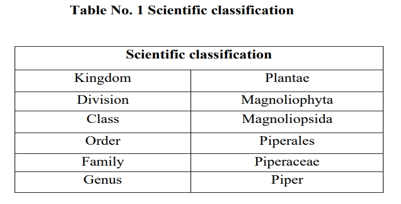
B. Sodium Hydroxide
- Non-proprietary Names:
BP: Sodium hydroxide
JP: Sodium hydroxide
Thear: Natrii hydroxidum
USPNF: Sodium hydroxide
2. Synonyms: Caustic soda; E524; lye, soda lye, sodium hydrate.
3. Chemical Name and CAS Registry Number: Sodium hydroxide [1310-73-2]
4. Empirical Formula and Molecular Weight: NaOH 40.00 5)Structural Formula:
5. Typical Properties V
Acidity/alkalinity:
pH 12 (0.05% w/w aqueous solution);
pH 13 (0.5% w/w aqueous solution);
pH14 (5% w/w aqueous solution)
V Melting point: 318°c V
Solubility of sodium hydroxide:
Ethanol
Ether
C. Calcium Carbonate
- BP. Calcium carbonate
PhEur: Calcii carbonas
JP. Precipitated calcium carbonate
USP: Calcium carbonate
2. Synonyms: Calcium carbonate (1:1); carbonic acid calcium salt 1:1, creta preparade; Destab; E170; MagGran CC, Micromite; Pharma- Carb, precipitated carbonate of lime, precipitated chalk; Vivapress Ca, Witcarb.
3. Chemical Name and CAS Registry Number: Carbonic acid, calcium salt (1:1) [471-34-1]
4. Empirical Formula and Molecular Weight: CaCO3, 100.09
5. Structural Formula
6. Functional Category: Buffering agent; coating agent; opacifier, tablet and capsule diluent, therapeutic agent.
7. Applications in Pharmaceutical Formulation or Technology: Calcium carbonate, employed as a pharmaceutical excipient, is mainly used in solid dosage forms as a diluent. It is also used as a base for medicated dental preparations, as a buffering agent, and as a dissolution aid in dispersible tablets. Calcium carbonate is used as a bulking agent in tablet sugar-coating processes and as an opacifier in tablet film coating.
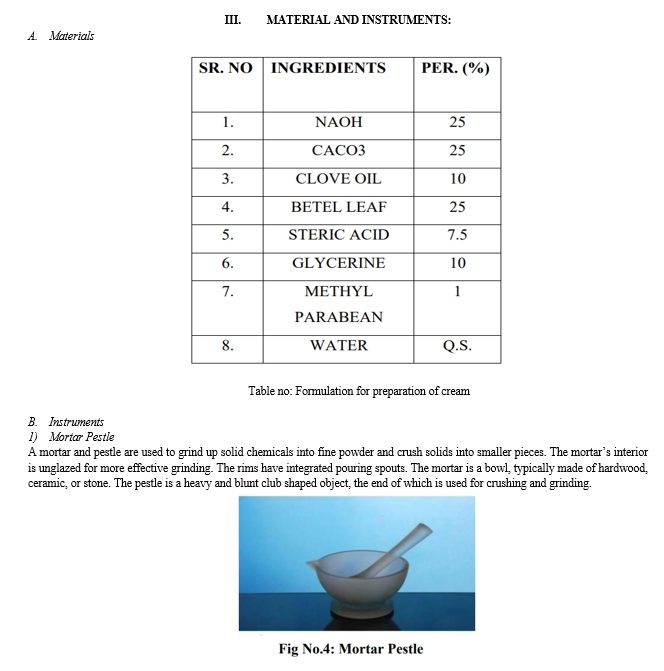
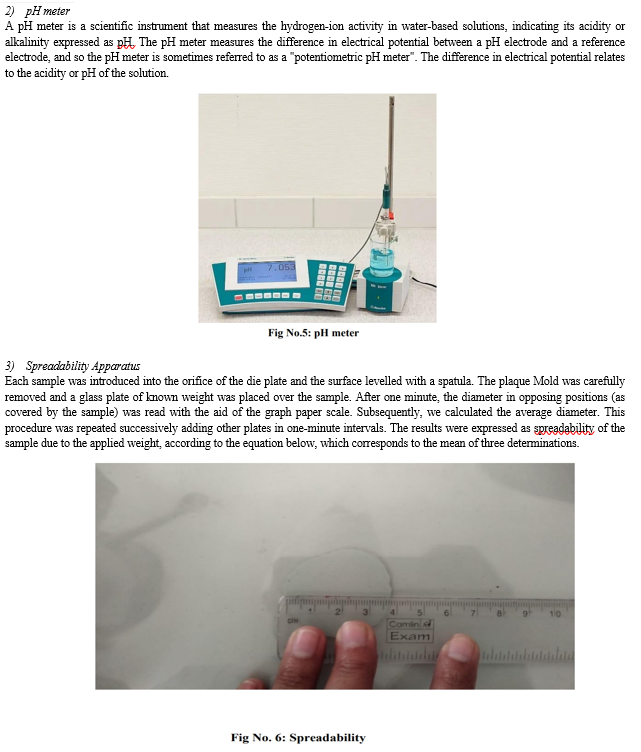

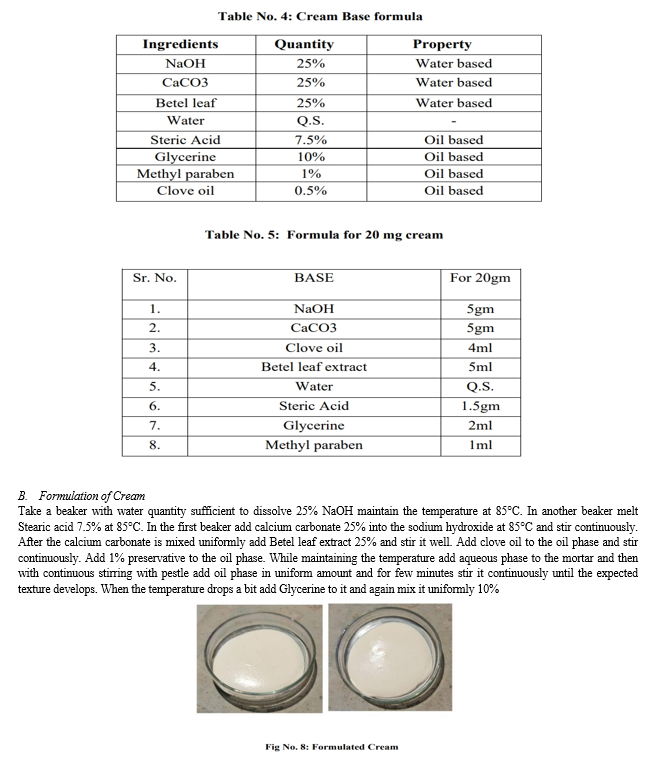
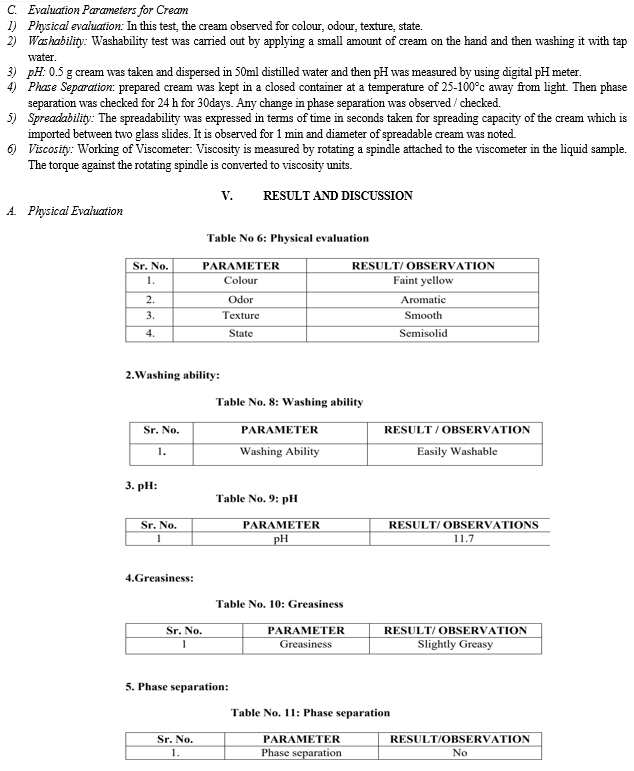

B. Discussion
Formulation and equation of wart removal cream using calcium carbonate, sodium hydroxide, stem of betel leaf which gives beneficial effect and formulation is stable and have ease of application.
Formulation and evaluation of wart removal cream using calcium carbonate, sodium hydroxide, stem of betel leaf which gives beneficial effect and formulation is stable and has ease of application. with other API this cream also includes Sodium Hydroxide and Calcium Carbonate. Sodium hydroxide gives some irritation that's why clove oil is used to use as an analgesic and to reduce the irritating effect. Instead of using other treatments to remove the warts this cream is easily applicable. As other methods like surgically removing the warts are time consuming and painful. This cream also prevents dehydration at the site of action because glycerine is added to it in proper proportion.
Conclusion
The following cream was made by using the Betel leaf extract, Sodium hydroxide and calcium carbonate as active pharmaceutical ingredients and are efficient for wart removal. As this cream has clove oil which is used as an analgesic to avoid the irritational pain. The pH of the cream is supposed to be basic and around 12- 12.5. During the evaluation the pH of the cream was found out to be 12.1. Cream was easily spreadable and it had a pleasant appearance. It was concluded that the cream was viscous enough as expected. It was found out that cream was easily applicable. It was found out the cream was stable and it didn\\\'t show any of the phase separation. It was enough moisturizing to avoid dehydration at the site of action. And it also helps to reduce the dark spot after the removal of the wart
References
[1] Rowe R, Sheskey P, et al. Handbook of Pharmaceutical Excipients. Ed 5th. United States: Pharmaceutical Press, American Pharmacists Association;2006 PN 80-81,301-305,377-381. [2] Indian Pharmacopoeia 2022. Government of India Ministry of Health and Family Welfare. Vol 3,4 The Indian Pharmacopoeia Commission Ghaziabad;2022 PN: 277-278,1297-1298. [3] Niazi S et al, METHOD FOR INSTANTANEOUS REMOVAL OF WARTS AND MOLES, Elder la Deerfield, IL United states patent.2001;60015 US 6,312,735. [4] Abeck D, Tetsch L, et al. Extragenital Cutaneous Warts Clinical Presentation, diagnosis and treatment. Journal der Deutschen Dermatologischen Gesellschaft.2019;17(6):26-29. [5] U R Sekhar Namburi et al. A review on management of warts in Ayurveda, National Library of Medicine.2011;3(1):5-9. [6] Biswas P, Uttpal A et al. Bettel vine(piper betel L.) A comprehensive insight into itsethnipharmacology, photochemistry and pharmacological, biomedical and therapeutic attributes. Journal of cellular and molecular medicine. 2022;26(11): 3083-3119. [7] Lynch M, Jones R et al. Management of cutaneous viral warts. BMJ. 2014;348(3339): 4256- 4259. [8] Jablonska S, Majewski S et al. Cutaneous warts. Clinics in dermatology. 1997;15(3): 309-319. [9] Guoling T. Disinfecting pest for dissolving wart and eliminating wart. 2017, CN101433617B. [10] Pandey P, Pal R et al. Formulation and evaluation of vanishing cream (cosmetics). ResearchGate. 2023;10(13140). [11] Cavallaro A. Gel for topical application of clove essential oil with broad spectrum of antiinflammatory action and method of preparing. 2015; US20150182587A1: PN 1-60. [12] Nofal A, Ragab E, et al. An Overview of Various Lines in The Treatment of Warts: Review Article. The Egyptian Journal of Hospital Medicine.2022;86(4):570-573. [13] Michelle M. Lipke. An Armamentarium of Wart Treatments. Clinical Medicine & Research.2006;4(5):273-293.
Copyright
Copyright © 2024 Akshay S. Gavali , Prof. Neha B. Gaikwad , Dr. Rajendra M. Kawade. This is an open access article distributed under the Creative Commons Attribution License, which permits unrestricted use, distribution, and reproduction in any medium, provided the original work is properly cited.

Download Paper
Paper Id : IJRASET63486
Publish Date : 2024-06-28
ISSN : 2321-9653
Publisher Name : IJRASET
DOI Link : Click Here
 Submit Paper Online
Submit Paper Online

